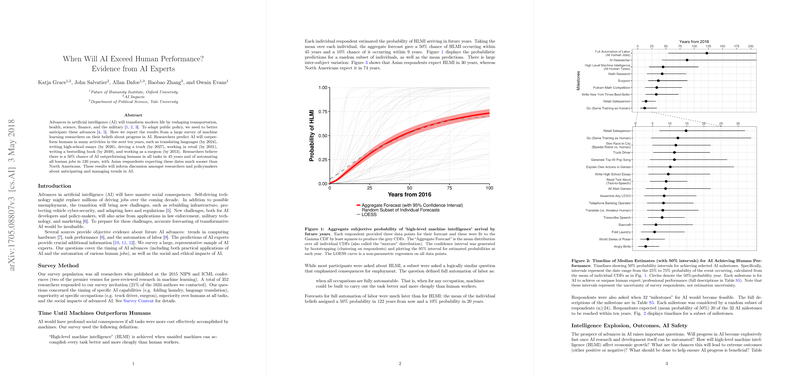Overview of "When Will AI Exceed Human Performance? Evidence from AI Experts"
The paper, authored by Grace et al., comprises a comprehensive survey of AI experts, exploring predictions regarding when AI might surpass human capabilities across various tasks. The authors engage with a representative sample of researchers from prominent AI conferences, NIPS and ICML, assessing anticipated timelines for AI superiority in specific roles and overall human-level machine intelligence (HLMI).
Methodology
Through a structured survey targeting 1634 researchers, of which 352 responded, the paper probes various AI milestones and tasks, exploring the timelines for potential AI advancements. Participants provided probabilistic forecasts on AI capabilities ranging from language translation to complex tasks like performing surgery and authoring best-selling books.
Findings and Numerical Results
The data reveals that experts anticipate:
- AI will surpass human performance in numerous areas within the next decade, with language translation predicted by 2024 and high-school essay writing by 2026.
- There is a 50% chance that AI will achieve HLMI in 45 years, with full automation of labor predicted to have a similar probability in 120 years.
- Significant regional differences in expectations: Asian researchers predict HLMI 30 years sooner than North Americans.
The survey also highlights that respondents expect 20 of the 32 AI milestones to be realized within the next ten years. This timeline underlines the rapid anticipated progress within the field.
Implications and Perspectives
The implications of these findings are multifaceted:
- Economic Impact: The prospect of AI performing at or above human levels in all tasks bears substantial economic significance, affecting employment and industry dynamics.
- Ethical and Social Considerations: The potential for both beneficial and catastrophic outcomes poses challenges for policymakers seeking to harness AI's capabilities while mitigating risks.
- Strategic Planning: As AI continues to advance, strategic efforts in research orientation and public policy are essential, particularly emphasizing AI safety research.
- Regional Variations: The geographical discrepancies in expectations suggest differing regional strategies and investments in AI development.
Future Directions
The survey underscores the evolving landscape of AI research and highlights the significance of accurate predictive models. Future studies could expand beyond the machine learning domain to include broader AI disciplines. The trends identified in the paper suggest an accelerating pace in AI development, calling for continued assessment of both potential risks and opportunities.
Conclusion
The paper provides an empirical basis for understanding expert expectations in AI development timelines, contributing valuable insights for both academic research and policy formulation. The alignment between expert predictions and actual AI advancements over subsequent periods may further inform the reliability and calibration of expert predictions in AI and other emerging technologies.
